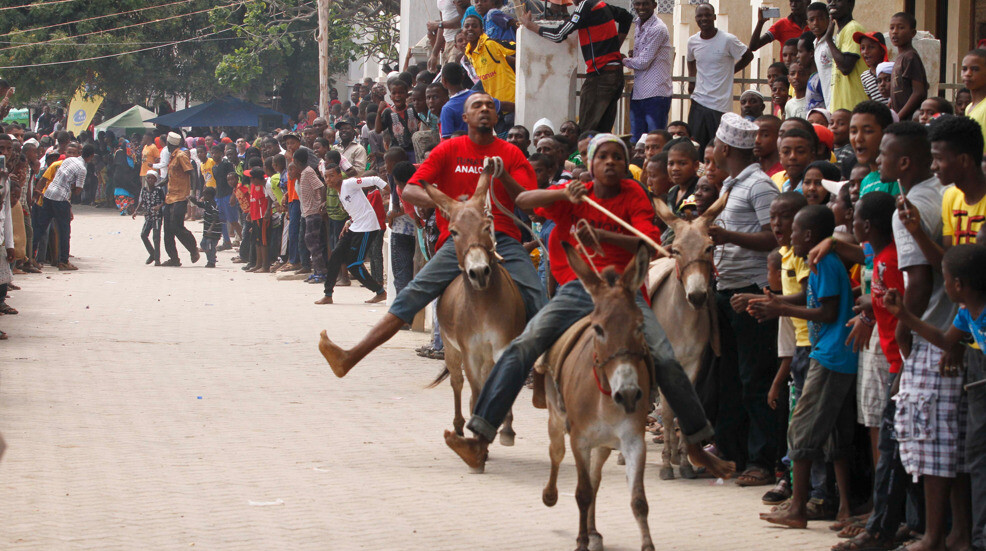Lamu Cultural Festival: Everything you need to know
What is the Lamu Archipelago?
The charming island of Lamu, which is located off the coast of Kenya, is a place where history is spoken through its winding lanes and where time seems to have stopped.
Lamu is a living example of the intricate history of East Africa with its well-preserved Swahili architecture, magnificent beaches, and thriving cultural heritage. Listed as a UNESCO World Heritage Site, you’ll have the opportunity tour the ancient stone buildings with finely carved doors and windows that make up Lamu’s old town.
Beyond its stunning architecture, Lamu offers a tranquil retreat from the bustle of modern life. Here, donkeys serve as the main form of transportation and people live quiet and modest lives.
Lamu is a mesmerizing location that invites you to travel back in time and savor the spirit of a bygone era. Whether you’re drawn to it because of its yearly Lamu Cultural Festival, its delectable Swahili cuisine, or the peaceful sound of lapping waves along its coasts. Because of this, it makes it one of the most visited beach destinations in Kenya.
Read more: The Best Things To Do In Lamu
What is the Lamu Cultural Festival and what does it entail?
Every year, the Lamu Cultural Festival takes place on Lamu Island. This celebration honors the rich cultural legacy and customs of the long-established Swahili population in this area. I’ve listed below 7 reasons why the Lamu Cultural Festival is so unique and why you definitely need to add it to your bucket list when visiting Kenya!
1. Experience Traditional Dhow Races
Traditional dhow races in Lamu are a beloved and enthralling aspect of the island’s cultural history. These races honor the historical significance of dhows in Lamu’s maritime customs and trading history.

As the races go, local sailors and fisherman demonstrate their prowess and ability to work together by helming these recognizable wooden sailing vessels. The colorful sails of dhows, blow in the wind as they smoothly cross the water, providing an amazing spectacle.
In order to accommodate diverse types and sizes of dhows and guarantee widespread participation, the competition includes a variety of categories, from short-distance sprints to lengthy endurance races.
The dhows, which are decked out in vivid colors and traditional patterns, give the occasion a festive feel and bring together large crowds of people. Fans come out to support their preferred dhows and crews, making it an amazing atmosphere to be a part of.
2. Check out all the authentic swahili Arts & crafts exhibitions
During the festival, local artisans and craftsmen display a range of handcrafted products. These include delicate woodwork, jewelry, textiles, and more, to demonstrate their expertise. You’ll have the opportunity to support local artists by purchasing one-of-a-kind souvenirs.
3. Experience Traditional Swahili Music and Dance
During the Lamu Cultural Festival you can take in performances of traditional Swahili music and dance. This is an essential component of the community’s culture. In these performances, traditional instruments and compelling rhythms are frequently used.
4. Fill your belly with delicious swahili food
The festival is a wonderful opportunity to try some delectable street food and Swahili delicacies. The flavors of traditional Swahili food, such as biryani, samosas, and freshly caught seafood are second to none!
5. Witness amazing Cultural Parades
The parade participants wear traditional Swahili garb, which frequently consists of elaborately crafted clothing, headgear, and accessories. These clothes are a reflection of the Lamu Archipelago’s rich cultural heritage.
Lively music and traditional Swahili dance performances are played during the parades. A lively and rhythmic environment is produced by musicians using regional instruments like drums, flutes, and stringed instruments.
The parades consist of colorful processions that wind their way through the narrow, stone-paved streets of Lamu Old Town. The participants, often representing different communities and cultural groups, march together, displaying their unique customs and traditions.
A cheerful and happy environment is created by the Lamu Cultural Parades. Streets are lined with spectators who queue to witness the vibrant processions, dance to the music, and engage with the participants.
6. Watch Donkey Races
The donkey races are a lighthearted competition where locals and visitors come together to cheer for their favorite donkey and jockey. The races usually take place on a designated track or path. Participants decorate the donkeys with colorful attire and accessories, creating a festive atmosphere. It’s not only a fun spectacle but also a way for the community to showcase their donkeys’ agility and speed.

Spectators gather along the racecourse to watch the races, and there’s usually plenty of laughter and excitement as the donkeys dash to the finish line. The races often include different categories, such as short-distance sprints and longer endurance races.
7. Take part in Cultural workshops and talks on Swahili Culture
The Lamu Cultural Workshops are an essential component of the annual Lamu Cultural Festival, providing visitors with an engaging and instructive experience. These classes offer a practical chance to explore the island’s rich cultural legacy.
You can participate in a variety of traditional crafts and activities under the direction of local artists and specialists who have received their knowledge from earlier generations.
These programs provide insight into the island’s artisanal traditions. Whether it’s studying the craft of traditional basket weaving, mastering the nuances of wood carving, or discovering the flavors of real Swahili cuisine through cooking sessions.
Additionally, they frequently incorporate discussions and presentations about Lamu’s history, traditions, and cultural practices to contextualize the hands-on learning.
Where to stay during the festival
Peponi Hotel Lamu: The iconic Peponi Hotel, a family-run establishment with a prime beachside setting, is situated in Shela Village. It’s the ideal blend of island charm and elegance.
The Majlis Resort: Situated on Manda Island, The Majlis Resort offers a luxurious and tranquil escape. With stunning views of the Indian Ocean, spacious rooms, and various water-based activities, it’s a top choice for a relaxing getaway.
Kizingo: It is situated on the isolated western shore of Lamu Island, and provides a private and dreamy beachfront experience. The large bandas (thatched cottages) offer a comfortable and peaceful getaway.
Lamu House Hotel: This boutique hotel in Lamu Old Town boasts beautifully designed rooms, an inviting pool, and a rooftop terrace with panoramic views of the town. It offers an authentic Lamu experience.
Forodhani House: Forodhani House offers comfortable accommodations with a historic feel. Its location provides easy access to the town’s attractions. It’s another excellent option in Lamu Old Town.
These are some of my favorite places in Lamu. However, you can also have a look at Airbnb as there are a lot of wonderful properties listed for all price ranges.
How to get to Lamu
Nairobi to Mombasa (by Air or Road):
By Air: Taking a domestic flight from Nairobi Wilson Airport to Lamu Airport is the quickest option. This route is serviced by a number of airlines, and flights last one to one and a half hours.
By Road: Another option is to drive or take a long-distance bus from Nairobi to Mombasa, which will take you 8 to 10 hours.
Mombasa to Lamu (by Air or Bus):
By Air: You can fly domestically from Mombasa to Lamu Airport. It takes around an hour to complete the flight. There are numerous airlines that fly this route. You’ll need to take a quick boat journey across the canal from Lamu Airport to the Island, which lies close by.
By Bus and Boat: Alternatively, you can take a bus or taxi from Mombasa to the coastal town of Mokowe, which is the gateway to Lamu Island. The journey takes around 6-8 hours. From Mokowe, you can catch a boat (usually a dhow) to Lamu Town on Lamu Island. The boat ride is a scenic and traditional way to arrive on the island.
Tip: As someone who has done the trip multiple times, going by air is by far the most convenient and stress-free option. I’d therefore highly recommend paying a little more and getting a domestc flight ticket – it’s definitely worth the extra cost!
Conclusion
The Lamu Cultural Festival is a rich tapestry of history, customs, and community, not just a one-time occasion. It’s a celebration where the past and present joyfully embrace, providing a window into Lamu’s soul.
Visitors can fully immerse themselves in the island’s rich heritage through the vibrant parades, traditional dhow races, cultural seminars, and friendly hospitality of the inhabitants. During this time, Swahili music fills the air, dancing, and laughter fill the streets, and the cheers of onlookers fill the shores of Lamu.


